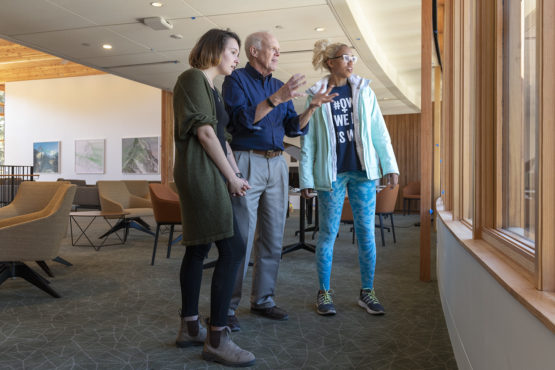Stanford welcomes inaugural cohort of Knight-Hennessy Scholars
The Knight-Hennessy Scholars program develops a community of future global leaders to address complex challenges through collaboration and innovation.
Stanford will celebrate the arrival of the first cohort of Knight-Hennessy Scholars on Saturday with Day One, an orientation program designed to introduce the students to each other and to the unique experiences that await them through its global leadership program.
The scholars – 51 graduate students from across the United States and around the world – are pursuing degrees in 31 departments from all seven of Stanford’s schools: Business; Earth, Energy & Environmental Sciences; Education; Engineering; Humanities and Sciences; Law; and Medicine.

Knight-Hennessy Scholars Izzy Aguiar, left, and Brandi Ransom, right, stopped by the Denning House on Thursday and looked around the new building with former Stanford President John L. Hennessy, who co-founded the program. (Image credit: L.A. Cicero)
The Knight-Hennessy Scholars program, which Stanford announced in 2016, prepares scholars with the depth and range of subject expertise to identify, understand and confront the numerous grand challenges and opportunities of the future. Students selected as Knight-Hennessy Scholars receive full funding to pursue graduate studies at Stanford.
“We have prepared an invigorating orientation program for the scholars that highlights the unique experiences Stanford has to offer and will accelerate their ability to navigate across disciplines and find common goals with one another,” said former Stanford president John L. Hennessy, who co-founded the program and serves as its Shriram Family Director.
Getting to know one another
The orientation program will open with an interactive workshop on storytelling and close with the program’s first Leadership by Example conversation, which will feature co-founders Phil Knight, MBA ’62, philanthropist, business leader and co-founder of Nike Inc., and Hennessy, author of the new book Leading Matters: Lessons from My Journey, published by Stanford University Press.
The scholars will tour the O’Donohue Family Stanford Educational Farm, a project of the School of Earth, Energy and Environmental Sciences, and gather for a discussion on When Breath Becomes Air, a memoir on matters of life and death by Dr. Paul Kalanithi, a Stanford neurosurgeon who died at 37, less than two years after receiving a cancer diagnosis. The scholars will also participate in an interactive exercise that allows them to examine, develop and share their personal statements of core values in order to understand what they stand for as a group.
“One of the things we hope will distinguish Knight-Hennessy Scholars from other great graduate scholarship opportunities is that we are intentionally forming a community of scholars,” said Jeff Wachtel, executive director of the program.
As the scholars arrived on campus in recent weeks, they came together at regular welcome lunches hosted by Knight-Hennessy staff.
Gatherings throughout the year
During the academic year, the Knight-Hennessy Scholars will gather at Denning House, a new building located in the heart of campus that will serve as the convening hub for scholars and distinguished visitors.
At the threshold of the building, which is located on Lomita Drive, is a large-scale abstract bronze sculpture by Ursula von Rydingsvard. The 17-foot-tall artwork, MOCNA, is the first commissioned piece in the Denning House Collection, which has also acquired two works by the artist Trevor Paglen.
During autumn quarter, the program’s Leadership by Example conversations will feature George P. Shultz, former U.S. Secretary of State and the Thomas W. and Susan B. Ford Distinguished Fellow at the Hoover Institution, and Susan Wojcicki, chief executive officer of YouTube.
In October, the program will launch a five-week seminar series, Frontiers of Knowledge, featuring Stanford faculty discussing key research on pressing global issues, including international relations, immigration, artificial intelligence, genome editing and economics.
The series will open with a session by Michael McFaul, a professor of political science and director of the Freeman Spogli Institute for International Studies. McFaul, who served as the U.S. ambassador to Russia from 2012 to 2014, will discuss U.S.-Russia relations.
The art of listening is also on the agenda for the scholars. During autumn quarter, presentations by Rob Kapilow, an American composer, conductor and music commentator, and the St. Lawrence String Quartet – Stanford’s ensemble-in-residence – will showcase music as a way to develop listening skills in all contexts, including when scholars are confronted with views different than their own.
“While the scholars will be focused on acquiring knowledge and expertise in their chosen academic fields during the year, we also want them to learn how to communicate, collaborate and innovate with fellow Knight-Hennessy Scholars from other disciplines,” Wachtel said. “Those relationships will be essential to their ability to deeply understand complex issues and discover new solutions that advance humanity.”
During winter quarter, Knight-Hennessy Scholars will launch its fellow-in-residence program with archaeologist John Hale, director of liberal studies at the University of Louisville. Hale, author of The Art of Public Speaking: Lessons from the Greatest Speeches in History, will teach a course that examines great speeches, including “I Have a Dream,” delivered by the Rev. Martin Luther King Jr. at the Lincoln Memorial in Washington, D.C. during the 1963 March on Washington for Jobs and Freedom.
During the 2019-20 academic year, the program will increase its cohort of scholars to 75 graduate students. In 2020-21, the number will increase to a maximum of 100 scholars. Knight-Hennessy Scholars will announce its second cohort in February 2019.
